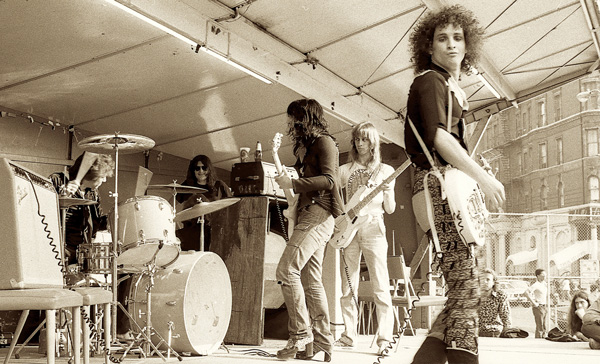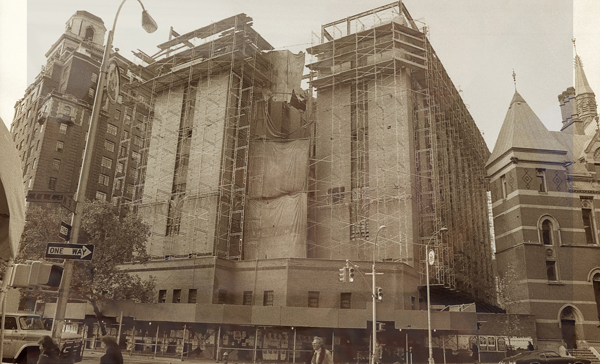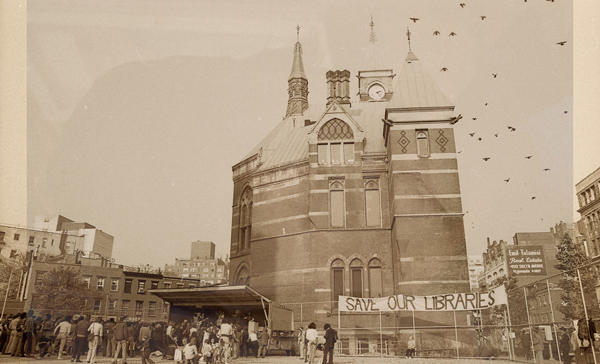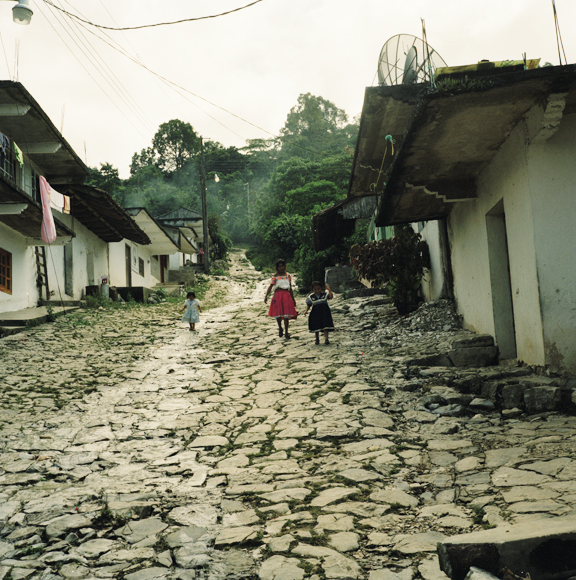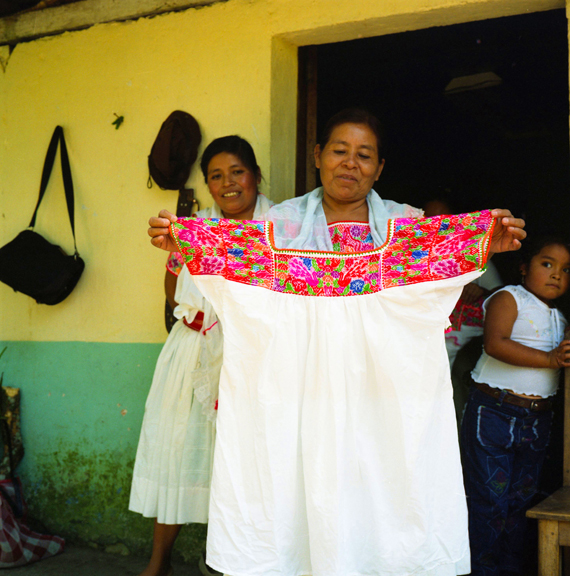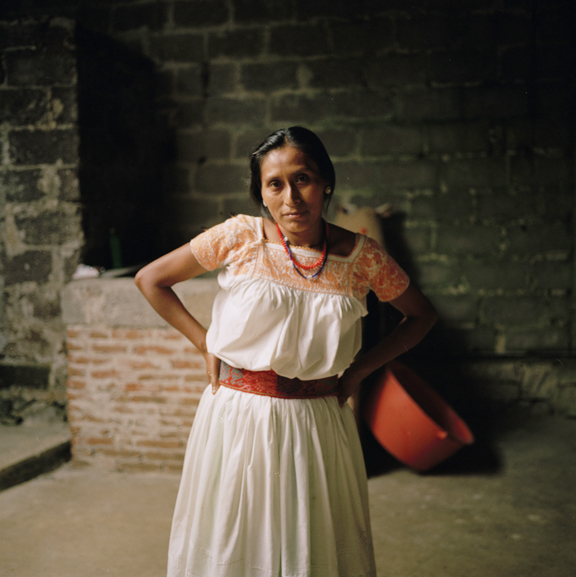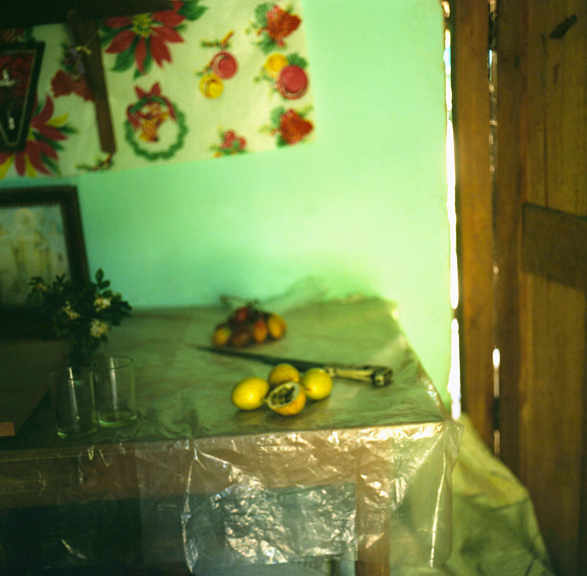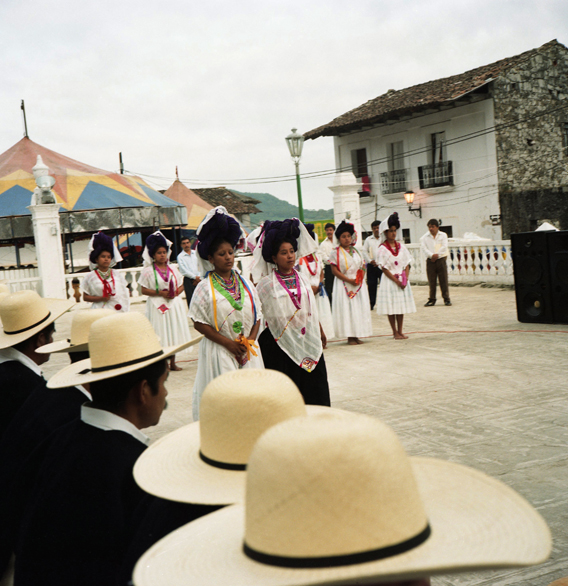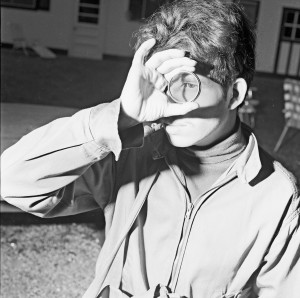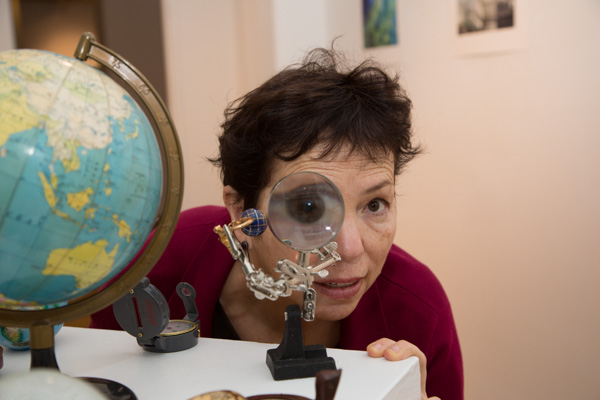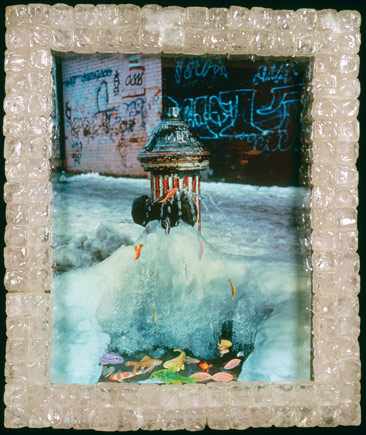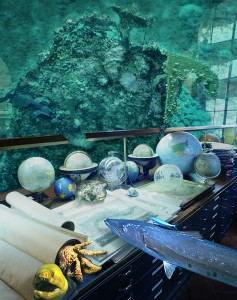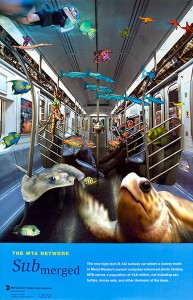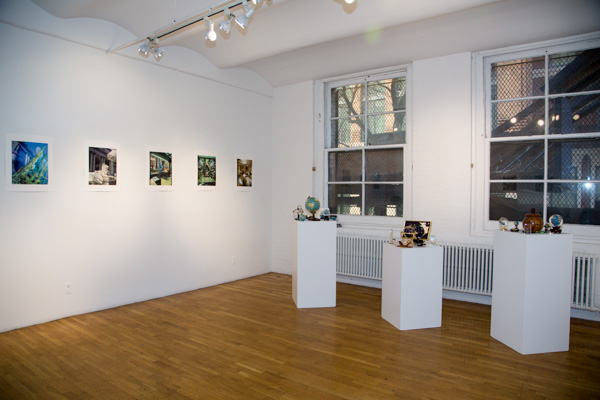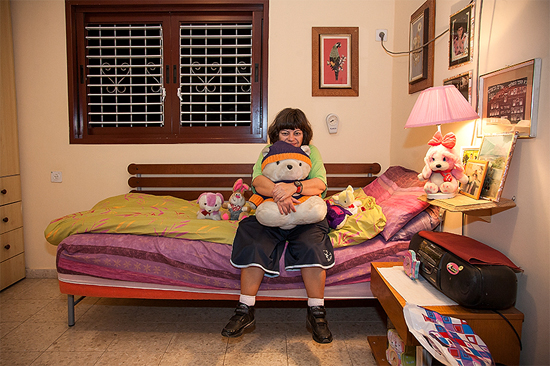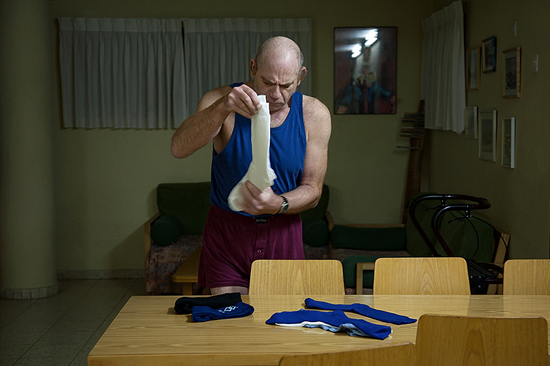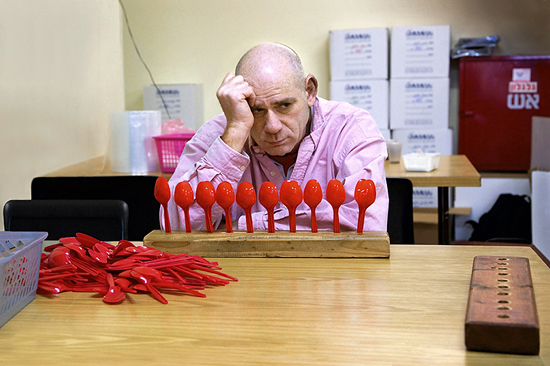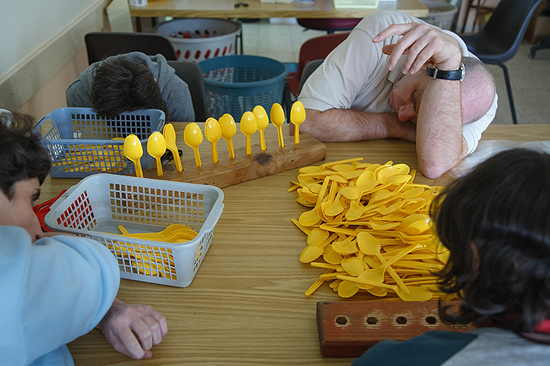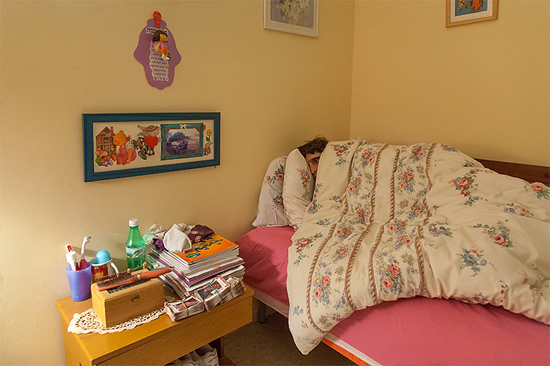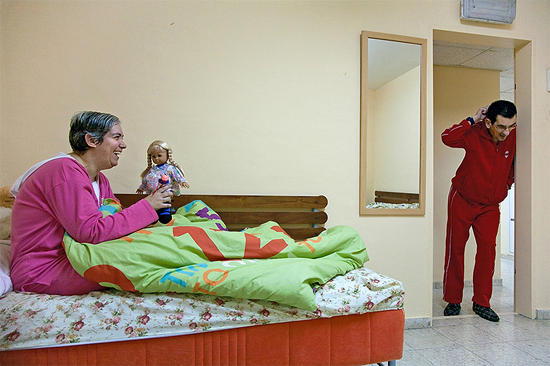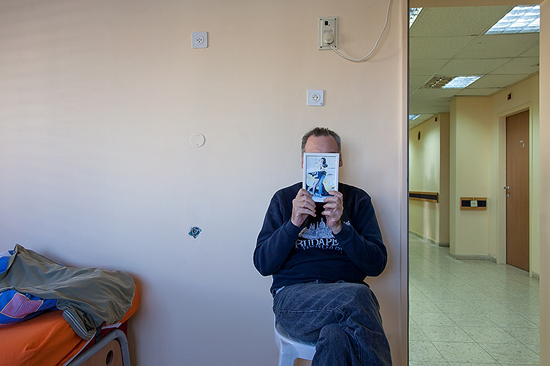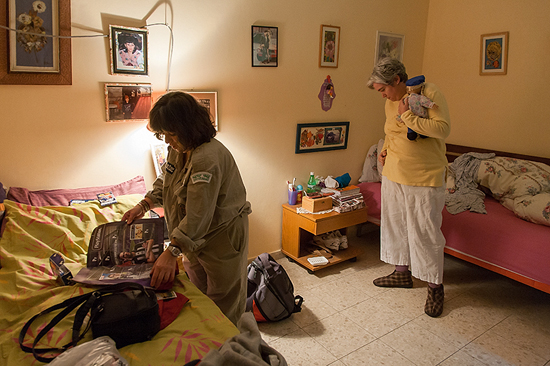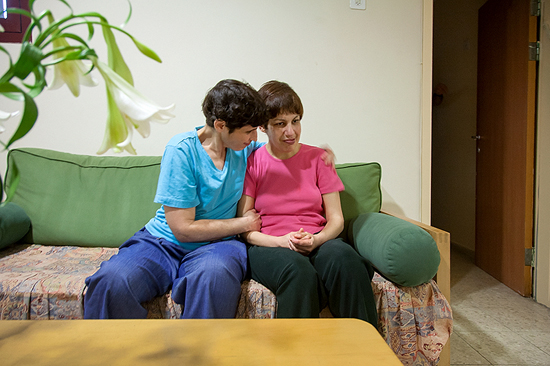Tag Archives: Catherine Kirkpatrick
NYC History on View at the Jefferson Market Library
As this image from Darleen Rubin’s exhibition Before the Garden shows, the NYC “Save Our Libraries” campaign has been around for decades. But never was it more glamorous than in 1974 when it was graced by the New York Dolls.
In this exhibit, Rubin, who has been photographing her West Village neighborhood for many years, focuses on change at the Jefferson Market Library. There are images of the dismantling of the infamous women’s house of detention next door, the garden that replaced it, and the NY Dolls performance. A must for students of city history and change.
Free. Through Feb. 25. At Jefferson Market Library (425 Sixth Ave., at 10th St.). Mon./Wed 10 a.m.–6 p.m. Tues./Thurs. 11 a.m.–6 p.m. Fri./Sat. 10 a.m.–5 p.m. For more info, visit nypl.org/events/exhibitions.
Studio Visit with Mary Teresa Giancoli
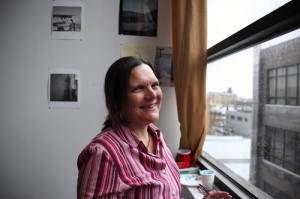 They work away like bees in a hive, quietly and industriously, in old manufacturing buildings in off-beat sections of the city. Artists, writers, designers, photographers. It’s always fascinating to visit and see work in progress. Recently I caught up with Mary Teresa Giancoli about her photographic exploration of Spanish culture in New York City and Mexico.
They work away like bees in a hive, quietly and industriously, in old manufacturing buildings in off-beat sections of the city. Artists, writers, designers, photographers. It’s always fascinating to visit and see work in progress. Recently I caught up with Mary Teresa Giancoli about her photographic exploration of Spanish culture in New York City and Mexico.
It’s not surprising to learn that Giancoli has a BA in Italian Culture from Wellesley College and an MFA in photography from Hunter. Her work combines a lush visual style with a deep interest in the customs of distinct Spanish communities. Her grandfather was born in Mexico, and many traditions were passed down through her mother’s side of the family. So it is not surprising that in the late 1990′s, Giancoli was drawn to photograph the Mexican communities in New York. 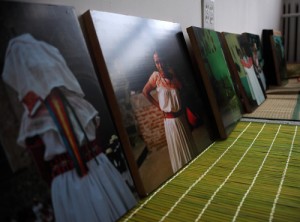
She began the project on December 12, 1997 in Our Lady of Guadalupe, a small church on West 14th Street where the mass is said in Spanish. She established a connection through a guitarist who was willing to serve as her guide into the community. She relied on natural light and asked permission before taking pictures. She worked on her Spanish. Still, it took a long time for her to “break in,” and she attended many events all over the city, slowly accumulating a body of work.
After the opening of a solo show at the UAM (universidad autónoma metropolitana) in México City, Giancoli visited the small town of Cuetzalan, halfway between Puebla and Veracruz. It is rural and lush, struggling to improve itself economically while trying to hold onto traditional ways.
She was drawn to the Maseualsiuamej, a cooperative of women who banded together in 1985 to gain independence. They broke economic ties with men, got a micro loan to manage an eco-hotel, established a tortilla factory, and began to sell their beautiful needlework in the markets to gringos.
Which strikes a note because the organization I am writing for, Professional Women Photographers, was founded by women photographers banding together to help other women photographers because at the time, no one else would. It was 1975, and there were few opportunities for women in the field. All of those who forged ahead have stories, some funny, some sad, about discrimination, and most struggled fiercely to survive.
Giancoli’s photographs capture the rhythm and texture of the Cuetzalan women’s lives, from their brightly colored home interiors to the beautiful blouses they make, which incorporate symbolically local flora and fauna–wild turkeys, lush vegetation, and exotic fruit like maracuya.
Giancoli also photographed a festival in which young women compete to represent their area and customs. As she describes it: “The festival of the Huipil (from Nahuatl, an Aztec language, meaning blouse or dress) revives indigenous customs in music, dance as a response to people who were displaced from their land and beliefs.”
“The Huipil contest is held in October to honor a young woman. Contestants are fourteen to twenty years old, fluent in their native tongue, Nahuatl and Spanish, know how to weave and perform domestic work in rural communities. The young women are judged on their beauty and purity of their customs. The Tatiaxas, a council of men, delivers the vote of the winner in a hat to the lead Tatiaxa. The Huipil Queen is carried through town, and dancing breaks out in the Plaza of San Francisco.”
When she came, the people of Cuetzalan told Giancoli they had been photographed before, but never seen any pictures. Not only did she win their trust, but gave them back beautiful and sincere images of themselves.
To see more, visit her website. All the photographs are archival digital prints on solid bamboo, 15″ x 15.” She will open her studio during the Long Island City Festival of the Arts on Saturday, May 17th 3-6 pm, and Sunday May 18th 3-6 pm, and by appointment. She will also lead a photo tour along the waterfront on May 17th.
John Milisenda: Photography, Family and Time
In a personal document, John Milisenda has photographed his family, mother, father and brother for almost fifty years. These images are in museums and private collections, including the Museum of Modern Art, the New Orleans Museum of Modern Art, and Bibliotheque Nationale in Paris, and have been in over one hundred and thirty shows. Milisenda has taught basic photography, the Zone System and Photographic Chemistry at Drexel University, the New School For Social Research and Parsons School of Design. He has written articles for Modern Photography and Photo Methods Magazine. Currently he works with methods that combine digital and traditional photography. In keeping with his interest in and deep knowledge of photographic processes, he maintains a darkroom in which he mixes all his chemistry, and experiments with various papers and films.
Milisenda is a native New Yorker who found quiet poetry in the Lower East Side neighborhood where he grew up, and in his family which he has photographed over many years. Click here to see a short video photo-essay of his work on his developmentally disabled brother:
(May take a minute to load)
- Catherine Kirkpatrick
PWP Member Spotlight: Meryl Meisler at Westbeth Gallery
Professional Women Photographers’ member Meryl Meisler is featured in Omens of Climate Change at Manhattan’s Westbeth Gallery from February 1 – 16. Her exhibition space (two rooms!) is devoted to her Immersions series featuring New York City landmark buildings submerged under water and filled with aquatic creatures.
PWP: You are known for your tough pictures of Bushwick in the 1980′s. Why did you turn to a subject matter that embraces lightness and whimsey?
MM: In addition to being an art teacher in the New York City school system, I was also a freelance illustrator, and did a lot of work for educational publishers, including the New York Times Science Times, and Scholastic (Sea Otters: Little Clowns of The Sea).
When I was teaching in Bushwick, I started painting directly on my Cibachrome prints in a whimsical fashion. I also became a certified scuba diver, bought an underwater Nikonos camera and flash, and began photographing my underwater adventures in Florida, Mexico, the Bahamas, Honduras and Florida. I read Twenty Thousand Leagues Under The Sea by Jules Verne and had visions of my beloved New York City submerged like Atlantis.
My work was published in Print Magazine and Zoom, and in 1991, I got a call from the art director of a new software company who selected me to come to the Maine Center for Creative Imaging to be among the first artists trained by Apple and Adobe to work on the Macintosh Computer with a new application: Adobe Photoshop. I was hooked, and began making digital images and mixed media sculptures based on aquatic themes.
PWP: What was involved in gaining access to the buildings?
MM: In 1995, I was selected by the MTA Arts for Transit to create an installation in twelve light boxes in Grand Central Station. My proposal to was “submerge” the terminal digitally, and I received permission to photograph there with a tripod and medium format camera. The resulting installation, Grand Splash, 1995-1996, was a huge success, the MTA’s first exhibit of digital work. It was featured in WIRED Magazine and Print Magazine, in addition to TimeOut and other periodicals.
I wanted to continue, and worked for three years to get permission to photograph the New York Public Library at 42nd Street and Fifth Avenue without paying licensing or rental costs (typically thousands of dollars).
I was also commissioned by the MTA Arts for Transit to create Submerged, an edition of 4,000 posters installed throughout the NYC transit system from 2001-2002. It went up on the day of my 50th birthday–what a celebration! I started “turtle watching,” going to every station throughout the city to see my poster, which was also a self portrait. The Submersions series was awarded a NYFA Catalogue grant.
The Immersions series was the main focus of my work from 1991 on, but during a 2002 exhibit at the ISE Cultural Foundation, my world collapsed. My father passed away suddenly, and my mother who had Alzheimer’s, required full time nursing care. I was very close to my parents, and the mourning and loss was deep and profound. After that, Immersions no longer seemed relevant to my life.
PWP: What‘s coming up next?
MM: In June 2014, coinciding with Bushwick Open Studios, I have a solo show, A Tale of Two Cities: Disco Era Bushwick opening at the Bizarre Black Box Gallery. I frequented and documented the hottest NYC discos in the late 70’s early 80’s, but have never shown these pictures. Juxtaposed with Bushwick images from the early 80s and now, the installation will have the look and feel of a disco. The “Bridge and Tunnel” crowd barred from those velvet ropes and disco doors is now the hip crowd!
So many images, so little time!
Interview by Catherine Kirkpatrick
Lessons Through A Lens: Photographer Irith Gubi
Irith Gubi is freelance and fine art photographer who lives and works in Israel. I met her recently when she visited New York, and was very impressed by a documentary series she did on the residents of Freiman House, a home for people with moderate retardation. Here are some of her images and thoughts about the project.
As a child I loved to draw, but on my eleventh birthday asked my parents for a camera and received a black plastic Agfa Instamatic. Though I loved taking apart and reassembling small appliances, the camera remained intact and I loved using it.
While my mother was the official photographer of family events, I used my new camera to explore my close surroundings. In high school, photography meant spending hours in the dark room. It was only after I started a family and took advanced courses, that I really began to understand and appreciate it.
I am curious by nature, interested in a many things, but most of all in the human experience. The more I was drawn to photography, the more I learned about the world around me, and also about myself. The camera makes it easier to approach people and deal with ambiguous and difficult situations, and also serves as a mirror reflecting myself. Looking at my work, I see issues that concern me, and sometimes solutions to unanswered questions. Photography is one of my strongest passions.
In photography school, as part of a social documentary course, I had an assignment to follow a person or a group, connect and get to know them gradually, then document their everyday life. I was fascinated by the images of the great social photographers and the considerable time and effort they invested in their projects. They were a great inspiration for me, and I was determined to find a special group of people that I could get to know.
In my city of Givataim, next to Tel Aviv, I used to see an unusual group of people passing through my quiet neighborhood. Their posture and body language suggested they were less aware of themselves than ordinary people, and some were very friendly and waved at passersby on the street. I was curious as to who they were and where they were going, and one morning found myself following a man from the group. I felt somewhat unethical, but was determined to satisfy my curiosity.
Yoram felt he was being followed, and increased his speed, and soon I was looking at myself from the outside–running down the street after a man I did not know. He went into the local grocery store, and I could hear his loud voice saying good morning to the shopkeeper. Then he came out, walking quickly, looking back at me until we reached the gate of a one-story building.
A sign said it was an employment center for people with disabilities. It took nearly three months for me to get all the approvals needed to join and photograph the group members at the employment center and the institution called Freiman House, where they lived and spent most of their time.
Freiman House residents suffer from mild to moderate mental retardation, and range in age from forty to to sixty-five. Most are independent and able to care for themselves to some extent; those who are less independent receive help and assistance from caregivers. They work at the employment center seven hours a day, five days a week and are engaged in a variety of easy crafts like binding cardboard folders, putting together small paper and wood decorations, counting teaspoons and putting them in bags. They are paid for their work.
Following my teachers’ guidelines, I visited the institution for the first time without a camera, introducing myself, telling the residents about the purpose of my project. Some of them were friendly and quick to connect. They wanted to know my age, the name of my husband, how many children I had. Some were less verbal, and I was especially impressed by one woman who suffered from depression and rarely spoke. She had a huge amount of emotional energy, and would hug me several times during each visit. Her embrace was strong and intense, it took me a while to get used to this gesture.
One man was very frustrated and troubled by the deterioration of his walking ability, and his speech was also very unclear. At the beginning of the project, he came up from behind, placed his hand strongly on my shoulder and terrified me. But I learned this was his way to communicate. I asked him not to repeat this, and he never did it again. Another woman who suffered from developmental disability was considered the most intelligent member of the group. On my first visit, she told me she did not belong there but had no other place to go. She was very clear in expressing who she liked and disliked, and though suspicious of me at first, developed trust as the project progressed.
After a few visits, when I finally came with a camera, everyone was curious and asked me to take their picture. I agreed, though these were not the kind of images I wanted to take. I wanted them to be unaware of me, hoping that they would go about their usual tasks so I could see their true, authentic behavior. Although they knew how to “act” in front of the camera, it was their genuineness and true nature I was after. This is what fascinates me when I photograph people–the real, unstaged situations where a true moment or sentiment can reveal something deep in a person’s soul.
Winning their trust was dependent on the time I spent there, and after a few weeks they almost didn’t notice me or the camera, and I could avoid superficial visuals that would show them in a trite or undignified way. Whenever I came to photograph them, they seemed content, and I think the photographic work made them feel important in their own eyes.
At the end of the course, I had a small body of work based on our short acquaintance, but felt it was not sufficient. I invited the group to the graduate exhibition at my school, and was moved to see their excitement when they saw themselves in pictures on the wall.
After graduation, I photographed Freiman House residents for more than a year and a half, resulting in an exhibition held at the town’s main gallery. The group members were also present at the opening, some accompanied by their families. Later the project earned an honorable mention at the PX3 photography competition in Paris.
The experience made me think about living in a place where others make all decisions for you about every aspect of your life. I also thought about the advantages of being in an environment where you get shelter and support without having to worry about your needs or reality beyond the walls.
Most of all, I was deeply touched. The residents taught me without words, in their own unique language, to be more empathic toward others, to accept and embrace all people regardless of their capabilities and limitations. Getting to know these special people was a life lesson for me and helped me appreciate the beauty in each and every human being.
– By Irith Gubi
– Edited by Catherine Kirkpatrick


